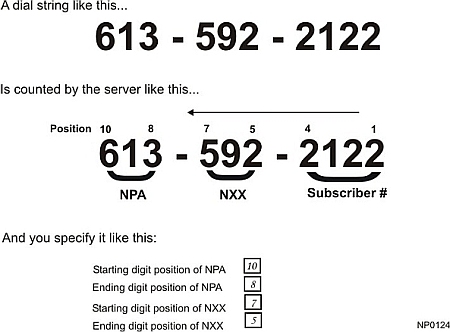
Organize the data you need to configure an RCOS using an RCOS Worksheet. The worksheet will help you set the parameters in the RCOS menu. The areas of the worksheet are described in detail below.
To configure an RCOS using the RCOS worksheet:
Identify the RCOS with a number from 1 through 64 and enter this number in the “RCOS to modify” box of the worksheet.
You have the option of naming the RCOS to easily identify it; you can enter up to 15 characters in the “RCOS name” box on the worksheet.
In the System Wide Parameters section, you define the NPA/NXX starting and ending positions that will apply to all RCOS. Any change you make here will affect the entire system. When specifying digit positions, be aware that the system counts the positions from right to left as shown here:

In the RCOS-specific section, you will define parameters that provide the following calling capabilities:
Home NPA: Because a system can connect to foreign exchange trunks, you must specify the “local” NPA for each RCOS. If a dial string does not contain an NPA, this number is added for the screening process. The system can accept a number of up to three digits for the NPA.
Digits to be Absorbed: Many calls contain numbers at the beginning of the dial string that allow access to outside lines, international calling, or pager systems. You must remove these numbers before the actual screening process can begin. Numbers entered in the Absorption Table are removed from the dial string before the screening process occurs. If the dial string does not contain any digits to be absorbed, there is an option to skip the balance of the call screening process. This facilitates outdial placement to other mailboxes on the system. The system absorbs the longest matching string in the absorption table from the dial string starting from the first digit. The table capacity is 16 patterns, with a maximum of 10 digits per pattern.
Exact Match Numbers Database: You can enter numbers in the exact match database and specify if they are to be allowed or disallowed. The table capacity is 100 patterns, with a maximum of 25 digits per pattern. Entries to this database should include common numbers that you do not want used for message addressing. Such numbers include 911, 411, 5551212, and 0.
NPA Database: The NPA database contains area codes that are screened. You can configure the database to either allow or disallow access to specific area codes. For example, you can restrict the mailbox to only the local NPA or restrict access to NPAs such as 900 numbers.
It is possible to restrict outdial access to only one NPA by setting the NPA allow/disallow status to allow and creating an NPA table with only one NPA entry. Remember that if you want to set any outdial restrictions for the home NPA, you must enter that NPA in the table.
NXX Database: After you specify an NPA, the system asks if you want NXX screening for the specific NPA. You must also set the allow/disallow status for the NXX field. The NXX allow or disallow setting takes priority over the NPA setting. This is useful for restricting the use of an NPA to only specific NXXs. The setting for the NPA in this situation is not used in determining if the call is placed. Call placement is determined only by the NXX allow/disallow setting. The system treats the combined NPA/NXX (408/415 for example) in light of the NXX allow/disallow setting, regardless of the NPA setting.
See a Sample RCOS Worksheet.
If an RCOS is changed, it is possible for a distribution list created before the RCOS change to contain some restricted telephone numbers. A restriction check is performed before each outdialing sequence to avoid calls being placed to restricted telephone numbers. If a telephone number fails the check, a receipt is generated stating “The following telephone numbers are restricted: [number 1], [number 2], etc.” This receipt is always generated, regardless of a mailbox owner request for cancellation of a receipt.